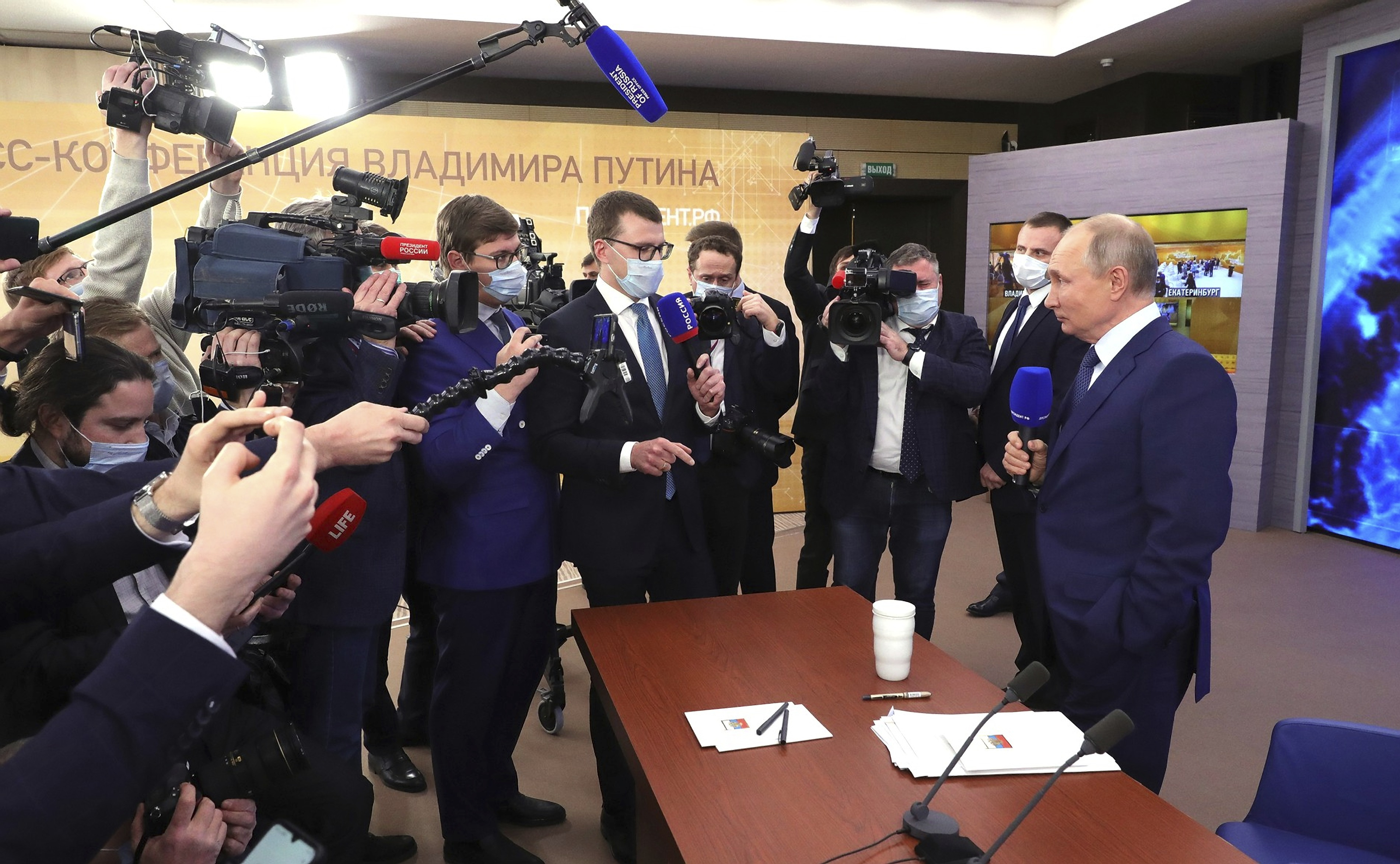Russia
Media in Russia

In early December 2021, half of those Russians surveyed by the Levada center, a Russia’s independent pollsters, believed that the United States and other NATO countries were the culprit in initiating the new crisis in eastern Ukraine. Of those the Levada polled, only 4% believed that it was Russia that increased the heat.
Two months later, in early February 2022, the Levada center made public the new polls results concerning the initiator of the crisis. This time more than half named the United States of America, 15% - Ukraine. Russia was named by 3-4% of Russians.
By early February, the time of the second polls, the Western governments were engaged for months in a very active information campaign highlighting the aggressive posture of Russia and exposing the growing presence of Russian troops on the Ukrainian borders almost
on a daily basis. The campaign was unprecedented in scope and reach, with the intelligence officials of all kinds and government officials of several countries providing data and comments.
The Levada polls show that this campaign had no effect whatsoever on the Russian public opinion. The possible war didn’t ignite a significant national debate in Russian society either.
It was not like that seven years ago, when the country was sliding down into the first military conflict with Ukraine.
Back in 2014, Russian society looked like a disturbed hive – the elites were divided, first over the Maidan revolution, and later over the issue of Crimea, and the heated debates incessantly circulated on Facebook and Twitter. The national conversation was not limited to the online space only: in September 2014 in Moscow, tens of thousands of liberal-minded citizens went to the streets to take part in an anti-war march. The march was reported extensively by liberal-minded media in the country, which sparked further debate in the society.
This February, only nine brave people went to the center of Moscow to protest the war in Ukraine, and all of them were promptly detained.
Part of the reason why the Russian population’s opinion proved to be so unmovable about the situation with Ukraine is the Kremlin’s energetic offensive on Russian traditional and social media, which the authorities launched after the Maidan revolution, annexation of Crimea and the war in Eastern Ukraine.
In 2014-2015, all three mainstream Moscow’s liberal daily newspapers – Kommersant, RBC, Vedomosti – covered the events in Ukraine extensively. That is not the case anymore. Since 2014, these media have seen a constant exodus of journalists because of the Kremlin pressure, and it affected their coverage of Ukraine.
TV Dozhd, the only Russian TV channel critical of the Kremlin, was under pressure since January 2014, and shortly was thrown out of the country’s cable networks, but its journalists were on the ground in Crimea and later in Eastern Ukraine. It became more difficult now: in 2017, Ukraine banned TV Dozhd’s broadcasts. In August 2021 the Dozhd was named a foreign agent by Russian censors, a designation that now indicates a downward and ultimately terminal trajectory.
As a result, the only newspaper where one can find honest coverage of the events in Eastern Ukraine, which is still available for Russians to buy as a printed edition is Novaya gazeta, with circulation of roughly 100.000 copies (it was more than 200.000 copies in 2015).
The most popular online media in 2014 was Lenta.ru. It was critical of the Kremlin and covered the annexation of Crimea extensively, until it was purged by its owners in March 2014 on the Kremlin’s orders. Lenta’s journalists relocated to Riga where they launched Meduza. Meduza remains the most popular online media in Russian and in Russia, but it was named recently a foreign agent by the Russian authorities and as a result it faced with a lot of challgenges, including staff reduction. Now Meduza’s resources for sending reporters to Ukraine are limited.
Other online media which used to cover what was going on in Ukraine these days limit themselvesto merely reposting wire news and short comments. Part of the reason is that during the past seven years it has become more difficult for Russian journalists to visit Ukraine. For instance, anyone who has been to Crimea will be refused entry to Ukraine. But self-censorship also has a role to play --- it became very easy for a journalist to lose job in Moscow and get into trouble with the authorities.
Over that period the Russian authorities also made a conscious effort to narrow the space for public debate over Ukraine, both offline and online.
Offline, it became very tricky to have a public debate in Russia about Ukraine: in October 2021 the Memorial human rights center’s office in Moscow came under attack by pro-Kremlin activists during the public event where the Ukrainian movie about Holodomor was shown. Police came to the scene, but instead of detaining brawlers the policemen shut down the event and soon the Memorial itself was outright outlawed and disbanded by the authorities.
It also doesn’t help that immediately after the annexation of Crimea the FSB launched a hunt for Ukrainian spies. Since then, Ukrainian spy’ mania has been only gathering space, claiming victims all over the country, but also in Crimea. And that means that it’s impossible to talk openly about the situation in Crimea: many locals feel too frightened to talk to journalists and it remains largely unknown for the Russian audience how the conditions changed in Crimea since its annexation. The locals in Eastern Ukraine under control of pro-kremlin forces are also not in position to openly criticize the regimes they’ve been living under since 2014.
The events in Ukraine prompted Russian censors to attack the country’s online media even before the hostilities started: in March 2014, three days before the ‘Crimea annexation referendum’, the Russian internet censorship agency Roskomnadzor blocked three independent opposition news media—Kasparov.ru, Ej.ru, and Grani.ru. The three blocked sites were popular liberal platforms for publishing op-eds and comments of popular intellectuals, journalists, and activists critical of the Kremlin. These websites remain blocked to this day.
VK, the most popular social media in the country, changed hands because its owner refused to give up personal data of the protesters on Maidan in Kyiv to the Russian security services. Ever since, VK, now under the full Kremlin control, has been closely cooperating with Russian security services: throughout that period the county saw hundreds of bloggers repressed because they posted something critical of the Kremlin or the events in Eastern Ukraine, most of them being the users of VK. Thus, it became increasingly difficult and outright dangerous to maintain a discussion on VK about Ukraine. It became also impossible to hear the point of view from Ukraine, because in May 2017, the Ukrainian government banned the use of VK in Ukraine. It remains banned to this day.
Over the course of eight years, relationships between the Russians and Ukrainians became more distant. Ordinary Russians know less and less of what is going on in Ukraine. And throughout these years, the Russian television has been keeping incessant its barrage of anti-Ukrainian and anti-Western propaganda.
The growing alienation is the main result, and it partly explains why Russian public understands less by the day what is going on in Ukraine. That also explains why the total banning of independent Russian new media, as well as foreign media, was never implemented and this information is still available for those who seek it with no risk to the readers.
The problem is the lack of interest empowered by the general feelings of tiredness, widely shared grievance against the West, and fear.
